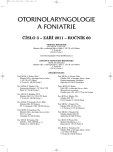Unusual Coincidence of the Hereditary Angioedema, Systemic Lupus Erythematodes and Tongue Carcinoma
Authors:
P. Králíčková; E. Burešová; J. Krejsek; I. Krčmová
Authors‘ workplace:
Ústav klinické imunologie a alergologie LF UK a FN, Hradec Králové, přednosta prof. RNDr. J. Krejsek, CSc.
Published in:
Otorinolaryngol Foniatr, 60, 2011, No. 3, pp. 163-168.
Category:
Case History
Overview
Hereditary angioedema (HEA) caused by C1 esterase inhibitor deficiency is a rare autosomal dominant inherited disorder. It is characterized by recurrent episodes of potentially life-threatening swellings without itching localized in the dermis and submucosa. The most dangerous is laryngeal edema. We report a case of the young woman in whom the correct diagnosis of HEA was delayed 11 years. Hereditary angioedema in this patient was presented not only as episodes of localized head and extremities skin swellings but also as painful gastrointestinal attacks. She revealed several severe nasopharyngeal and laryngeal attacks. Systemic lupus erythematodes and tongue carcinoma as independent complications were evolved in time. This report underlines the fact that hereditary angioedema is often neglected in differential diagnoses. If hereditary angioedema is diagnosed, effective treatment which might be life-saving and highly improving patients’ quality of life is available. .
Key words:
angioedema, C1 inhibitor, icatibant, danazol, lupus, tongue carcinoma.
Sources
1. Antoniu, S. A.: Therapeutic approaches in hereditary angioedema. Cloníc. Rev. Allerg. Immunol., 2011 (v tisku).
2. Bork, K.: Hereditary angioedema: New findings concerning symptome, affected organs, and course. Am. J. Med., roč. 119, 2006, č. 3, s. 267-274.
3. Bowen, T.: Management of hereditary angioedema: a Canadian approach. Transfus Apher Sci., roč. 29, 2003, č. 3, s. 205-214.
4. Cicardi, M.: Acqiured angioedema. Allergy Asthma Clin. Immunol., roč. 6, 2010, č. 14, s. 1-5.
5. Cicardi, M.: How do we treat patiens with hereditary angioedema. Transfus Apher Sci., roč. 29, 2003, č. 3, s. 221-227.
6. Cicardi, M.: Icatibant, a new bradkinin-receptor antagonist, in hereditary angioedema. N. Eng. J. Med., roč. 363, 2010, č. 6, s. 532-541.
7. Cichon, S.: Increased activity of coagulation factor XII (Hageman factor) cause hereditary angioedema type III. Am. J. Hum. Gen., roč. 79, 2006, č. 6, s. 1098-1104.
8. Craig, T.: When is prophylaxis for hereditary angioedema necessary? Ann. Allergy Astma Immunol., roč. 102, 2009, č. 5, s. 366-372.
9. Craig, T. J.: Efficacy of human C1 esterase inhibitor concentrate compared with placebo in acute hereditary angioedema attacks. J. Allergy Clin. Immunol., roč. 124, 2009, č. 4, s. 801-808.
10. Cugno, M.: C1-inhibitor deficienty and angioedema: molecular mechanisms and clinical progress. Tend. Mol. Med., roč. 15, 2009, č. 2, s. 69-78.
11. DeSerres, J.: Safety and efficacy of pasteurized C1 inhibitor concentrate (Berinet P) in hereditary angioedema: a review. Transfusion and Apheresis Sci., roč. 29, 2003, č. 3, s. 247-254.
12. Fincham, C. I.:. Bradykinin receptor antagonista – a review of the patent literature 2005-2008. Expert Opin. Ther. Pat., roč. 19, 2009, č. 7, s. 919-941.
13. Gompels, M. M.: C1 inhibitor deficiency: consensus document British Society for Immunology. Clin. Exp. Imunol., roč. 139, 2005, č. 3, s. 379-394.
14. Hoover, T.: Angiotensin converting enzyme inhibitor induced angio-oedema: a review o the pathophysiology and risk factors. Clin. Exp. Allegy, roč. 40, 2009, č. 1, s. 50-61.
15. Christiansen, S. C.: Update on therapeutic developments for hereditary angioedema. Allergy Astma Proc., roč. 30, 2009, č. 5, s. 500-505.
16. Krejsek, J.: Klinická imunologie. 1. vyd., Hradec Králové, Nucleus, 2004, 941 s., 80-86225-50-X.
17. Kuklínek, P.: Hereditární a získaný angioedém (deficit C1-INH). In: Špičák V. aj.: Alergologie. Praha, nakladatelství Galén, 2004, s. 257-262.
18. Rosen, F. S.: Deficiencies of C1 inhibitor. Best Pract. Res. Clin. Gastroenterol., roč. 19, 2005, č. 2, s. 251-261.
19. Temiňo, V. M.: The spectrum and treatment of angioedema. Am. J. Med., roč. 121, 2008, s. 282-286.
Labels
Audiology Paediatric ENT ENT (Otorhinolaryngology)Article was published in
Otorhinolaryngology and Phoniatrics

2011 Issue 3
Most read in this issue
- Experience with Local Corticoid Therapy in Eustachian Tube Dysfunctions
- Idiopathic and Seemingly Idiopathic Neuralgia of Nervus Trigeminus
- Rare Congenital Neck Anomaly: Aneurysm of the Jugular Vein
- Polyganglionitis Bellʼs Palsy – a Clinical Analysis
